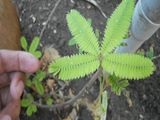1/1
rediscovering the magic of the sensitive plant at home
I remember my grandmother’s garden, where the sensitive plant—Mimosa pudica—grew like a secret waiting to be discovered. As a child, I’d gently touch its leaves, marveling as they folded up, shy and mysterious. Back then, gardening was about patience and tradition, about respecting the rhythms of nature. Today, I see my grandkids growing these same plants indoors under LED lights, eager for instant results and Instagram-worthy moments. But some things don’t change: the thrill of watching those delicate leaves respond to your touch, the way a simple plant can bridge generations. In our North American climate, sensitive plants are best started indoors in early spring, just as the last frost fades. I’ve found that soaking the seeds overnight—something my mother never bothered with—really helps them sprout. The old-timers might scoff at store-bought potting mixes, but I’ll admit, they work just fine if you’re short on time. Here’s where things get tricky: in the past, we’d let plants roam free, but now, communities worry about invasives. Some neighbors argue that keeping Mimosa pudica indoors is the only responsible choice, while others long for the wild, sprawling gardens of their youth. It’s a tug-of-war between environmental caution and the freedom to grow what we love. I’ve seen heated debates at local garden clubs—should we prioritize native species, or honor the plants that carry our family memories? As summer heat arrives, I move my pots to the sunniest window, misting them to mimic the humidity of their tropical home. The sensitive plant thrives on attention, but it’s fragile—one cold draft, and the leaves yellow overnight. My daughter prefers the convenience of plastic wrap and humidity domes, while I rely on instinct and the wisdom passed down through generations. When pests arrive, I reach for neem oil, recalling the old remedies my father used. But I warn my friends: avoid harsh soaps, or you’ll end up with blackened leaves and disappointment. And when the plant finally blooms, I let the seed pods dry, saving them for next year—a quiet act of hope and continuity. In a world where gardening trends shift with every season, the sensitive plant reminds me that some joys are timeless. Whether you’re a stickler for tradition or an advocate for innovation, there’s room in our gardens—and our hearts—for a little wonder and a lot of conversation. #sensitiveplant #gardeningmemories #intergenerationaldebate #Gardening
2025-06-19
write a comment...
